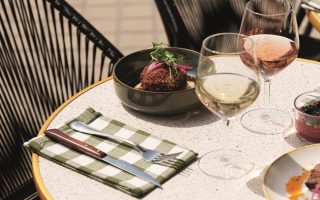A Pilgrimage in The Name of Art: The Tapestries of Dom Robert

I first learned about the Dom Robert tapestries from an article published in France Today (January 2017). Whilst reading, I was swept away by the dynamic images of the tapestries, instantly drawn in by this form of artwork. As an artist I’m attracted to bold colour, crisp design and nature, all fully present in those images on that page. Immediately I longed to see the work in person and began my quest to make it happen.
Opened in spring 2015, the Musée Dom Robert is housed in the Sorèze Abbey School. Sorèze is a small attractive village, north of the Canal du Midi and northwest of Carcassone, in the department of the Tarn, within the region of Occitanie. As we planned our trip, I envisioned a deviation from the autoroute to drive less than an hour to spend a night in Sorèze. Fortunately, my research informed me that the grand Hostellerie de l’Abbaye-Ècole is situated in the former monastery in a park-like setting, a short walk from the museum.

©Jo Anne Marquardt
We settled into a quiet, spacious room and were ready to visit the museum, open until 6 pm. We paid our entry fee at the counter and chose to use the audio guide to provide us with more detailed information. We proceeded to room #1 and followed the audio instructions to explore the ground level school and understand the history. The abbey was founded in 754 by Benedictines and became famous for its innovative teaching methods used from the 17th century until its closure in 1991. Established as the Royal Military School of Louis XVI, it welcomed students from all over the world. The various rooms were interesting, but we were here to see the tapestries.
Finally, after what seemed like being caught in a maze and listening to too much history, we showed our tickets at another counter and gained entry to a beautifully renovated section of the building on the upper floor. Many of the tapestries are monumental: bold and mesmerizing works of art. Nature was readily the inspiration for Dom Robert, born in 1907 and deceased in 1997. He was a monk at the Abbaye d’En-Calcat in the neighbouring commune of Dourgne, and demonstrated his keen attachment to nature with his numerous sketches and watercolors. In 1941, the tapestry artist Jean Lurçat made the acquaintance of Dom Robert and was touched by his highly original and sensitive work.

©Jo Anne Marquardt
Encouraged by Lurçat, Dom Robert worked up patterns to begin the process of creating tapestries. From 1942 to 1992, he created close to 150 tapestries, most fabricated by the Goubely atelier in Aubusson, which helped to revive tapestry manufacturing. I found the process Dom Robert used of transferring the designs into numbered patterns for the weavers to follow, truly mind boggling. There is an exhibit room set up showing how this process was achieved with a multitude of minuscule color changes made for the exacting patterns. Sitting before some of these majestic tapestries was a meditation on the power and wonder of nature. His lyrical quality creates a unique symphony of line and colour that plays to the inner child and soul. The disappointment came when the guard advised us it was time to leave; the museum closes promptly at 6 pm.
To culminate this surprising adventure, we had a memorable meal at a local restaurant appropriately called Le Tournesol. We devoured the house made cassoulet that was incredible. The restaurant itself is worth seeing, housed in a 17th century building with cozy rooms, beams, stone walls, fireplaces and clever decor.
“Il n’y a qu’une chose qui ne trompe pas, c’est la nature.”
“There is one thing that never deceives, it is nature.”
– Dom Robert
Share to: Facebook Twitter LinkedIn Email
Leave a reply
Your email address will not be published. Required fields are marked *




REPLY
REPLY
REPLY